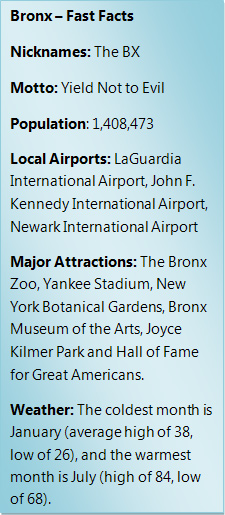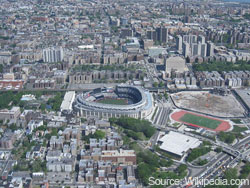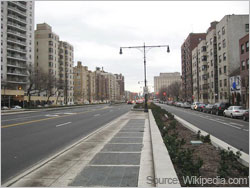 The Bronx is one of the five boroughs that comprise New York City and is the northernmost of the five boroughs, located to the north of Manhattan and Queens. It is the only borough that is located on the mainland and its total area is 42 square miles. The Bronx, which is its own county in itself, is the third most densely populated county in the United States with over 1.4 million inhabitants. The borough, which is divided into the East Bronx and West Bronx by the Bronx River, is a colorful and culturally diverse borough, with a sharp contrast in its neighborhoods that range between highly affluent areas and very poor, low-income areas that rank among the poorest in the country.
The Bronx is one of the five boroughs that comprise New York City and is the northernmost of the five boroughs, located to the north of Manhattan and Queens. It is the only borough that is located on the mainland and its total area is 42 square miles. The Bronx, which is its own county in itself, is the third most densely populated county in the United States with over 1.4 million inhabitants. The borough, which is divided into the East Bronx and West Bronx by the Bronx River, is a colorful and culturally diverse borough, with a sharp contrast in its neighborhoods that range between highly affluent areas and very poor, low-income areas that rank among the poorest in the country.
This guide will provide you with some helpful tips and information on just about everything you need to know if you're going to be making the move to Bronx. From the city's neighborhoods and school systems to the employment options and recreational activities available within the city, you'll find it all in this guide so that you can go into your move with the knowledge that is needed to make sure everything goes as smoothly as possible.
Bronx Climate
New York City has a widely varying climate that differs depending on where you are located. For example, the mild temperatures tend to mirror those of surrounding suburban areas in New Jersey and Connecticut, with high temperatures and high humidity in the summer months and chilly, windy weather during the winter with scattered snowstorms.
However, the city typically experiences four distinct seasons throughout the year, with the weather and temperatures remaining more temperate and mild during the fall and spring seasons than in the hot summers and cold winters. Snowfall in the city is common during the winter, although it doesn't tend to remain on the ground for very long and large accumulations are possible on rare occasions.
Bronx Geography and Neighborhoods
The Bronx, like all other New York City boroughs, has a lot of different neighborhoods. In fact, one of the most recent estimates put the number at 49. While it's difficult to describe all 49 neighborhoods and what makes each one unique, some of the more well-known neighborhoods in the borough include the South Bronx, Little Italy, and Riverdale. The Bronx River separates the borough into the East Bronx and West Bronx, and the borough also contains several small islands in the Long Island Sound, such as City Island and Hart Island.
While the neighborhoods in the Bronx, and throughout the rest of New York City, don't have any definitive borders or boundaries, they all tend to have their own unique character. The South Bronx, home to the legendary Yankee Stadium and the New York Yankees (lovingly nicknamed the "Bronx Bombers"), is also home to some of the poorest neighborhoods in the country and is typically a high-crime area that is best avoided unless you're attending a Yankees game and remain in the immediate area of the stadium which is commonly patrolled by a heavy police presence, especially on game days.
Living Costs in the City
 Despite containing several very poor, low-income neighborhoods, the costs of living in the Bronx are extremely high, as is typical for New York City. New York City remains one of the most expensive places in the country to live, if not the most expensive, with very high average rent payments and higher-than-average real estate prices to match the competitive nature of the New York City metropolitan area. Even in some of the poorer neighborhoods in the Bronx, rent remains very high and the various living expenses such as transportation, food and utilities runs much higher in New York City than almost anywhere else in the country. The median family income in Bronx is $34,744, which although lower than the national average for median family income, is also almost $20,000 lower than the median family income for New York as a whole.
Despite containing several very poor, low-income neighborhoods, the costs of living in the Bronx are extremely high, as is typical for New York City. New York City remains one of the most expensive places in the country to live, if not the most expensive, with very high average rent payments and higher-than-average real estate prices to match the competitive nature of the New York City metropolitan area. Even in some of the poorer neighborhoods in the Bronx, rent remains very high and the various living expenses such as transportation, food and utilities runs much higher in New York City than almost anywhere else in the country. The median family income in Bronx is $34,744, which although lower than the national average for median family income, is also almost $20,000 lower than the median family income for New York as a whole.
The median home price for an average home in Bronx is $391,000, extremely high and well above the national average, but on par with the high real estate prices that exist throughout the New York City metropolitan area, including most of Connecticut and New Jersey suburbs as well. Although the borough is undergoing a major revitalization that is aiming to turn things around from a down period that occurred during the 80s, it is still hard to live affordably in the Bronx.
Registering Your Car
Upon your arrival in New York after moving to the state permanently, you have a total of 30 days to update your registration and have your vehicle registered in the state before you may be required to pay a penalty. The state of New York also has laws in place that require your vehicle to pass standard emissions tests prior to registering your car. Also, you must provide proof of insurance that is valid in the state of New York.
A New York Driver's License can be obtained at any New York DMV location. The state requires new New York residents to update their license from their previous state to a New York driver's license. You may be required to pass several tests prior to receiving your new license. Also, there is a $10 fee to update your driver's license.
Bronx Moving Resources
Moving and storage companies are ready and willing to help you with your move to the Bronx, whether you're moving from out of state or from another county in New York. Make sure you get estimates from multiple moving services before you commit to hiring any (at least three estimates). Check back to our guides for tips on how to choose your moving service wisely with important questions to ask, differentiating between types of estimates, and mistakes to avoid. Visit the following pages at Movers.com to get quotes for the following services:
Bronx Schools
 Education in the Bronx is provided by the New York City Department of Education and there are a number of both public and private educational institutions located throughout the borough that are attended, not only by students who live in the Bronx, but also by students who commute from other neighboring boroughs. Of the nearly 95,000 Bronx residents who attend high school, almost 80,000 of them attend public high schools, including the elite Bronx High School of Science, DeWitt Clinton High School, School for Excellence, Bronx International High School, Herbert H. Lehman High School, Validus Preparatory Academy and Bronx Academy of Letters.
Education in the Bronx is provided by the New York City Department of Education and there are a number of both public and private educational institutions located throughout the borough that are attended, not only by students who live in the Bronx, but also by students who commute from other neighboring boroughs. Of the nearly 95,000 Bronx residents who attend high school, almost 80,000 of them attend public high schools, including the elite Bronx High School of Science, DeWitt Clinton High School, School for Excellence, Bronx International High School, Herbert H. Lehman High School, Validus Preparatory Academy and Bronx Academy of Letters.
There are also a large number of Catholic primary schools and Catholic high schools located throughout the borough such as St. Barnabas High School, Cardinal Hayes High School and Fordham Preparatory School. Speaking of Fordham, the largest institute of higher education in the Bronx is Fordham University, which has an 85-acre campus known as Rose Hill located in the borough. Other colleges in the Bronx include the City University of New York (CUNY), Bronx Community College and Manhattan College, among others.
Bronx Employment
Although much of the borough is undergoing a period of revitalization, with the city hoping to bring more businesses and people to the Bronx with construction of new buildings, housing and shopping areas, the borough of the Bronx is still experiencing a period of decline and the unemployment rates within the borough are incredibly high, nearing record levels of 14 percent only a year ago, despite recovering rates in other areas of the city. The current unemployment rate is still high, above 10.5 percent as of March 2013, while the job growth rate remains stagnant. Still, the borough remains economically stable for the most part, as it is part of the thriving economy of New York City.
Public Transportation
The public transportation system in the Bronx is operated by the New York City Metropolitan Transit Authority (MTA) which provides bus service throughout the borough, as well as the subway system that runs throughout the city, including in the Bronx. There are over 70 subway stations in the borough which are served by six different lines. In addition, the borough is connected to all surrounding boroughs by several bridges and tunnels that take commuters to Manhattan and Queens, such as the Bronx-Whitestone Bridge, the Triborough Bridge, the Throgs Neck Bridge. The George Washington Bridge is located on Interstate 95 and connects the Bronx to New Jersey.
There are also 11 Metro-North stations in the Bronx that serve passengers on two separate lines, providing service to Long Island, Connecticut, and other surrounding areas. There are three major airports located within driving distance of the Bronx, including LaGuardia International Airport in Queens, John F. Kennedy International Airport in Queens and Newark International Airport in Newark, New Jersey. All three airports offer daily commercial flights on most major airlines to both domestic and international destinations.
Culture and Contemporary Life
There are a lot of attractions and sights to see in New York City, so many that it may take you an entire lifetime to get around to seeing everything. The Bronx is no exception, and there are plenty of things to do and see within the borough. The most popular attraction in the Bronx, by far, is Yankee Stadium. The Grand Concourse is always buzzing during baseball season, and from April all the way through October, there is the excitement of Yankees baseball being played in the brand new Yankee Stadium, erected in 2009 right next door to where the legendary original building stood, which has since been torn down. If sports aren't quite your thing, then you can visit the New York Botanical Gardens and take in the scenery, or visit its neighbor, the Bronx Zoo. There are also several Off-Off-Broadway theaters located in the Bronx.
Moving to Bronx
Whatever your reasons for moving to Bronx, whether it be for a change of scenery or for employment, the city beckons you with its charm. The first step in the process of moving to Bronx is choosing a moving company after first checking their BBB ratings, insurance and license. The moving rates are charged by the hour if you are moving within the state boundary, while for a long distance move the charges will depend on the total weight or volume in cubic feet of your belongings. In the latter case, you can ask about a flat rate or any special discounts that are available with the mover.